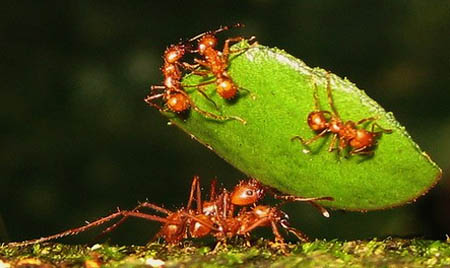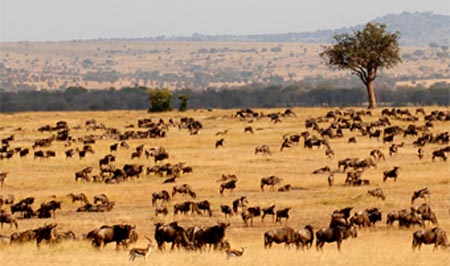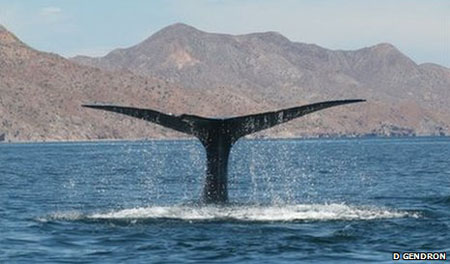|
|
|
National Wildlife Humane Society |
| Wildlife Conservation News |
|
|
|
| NWHS Intro |
| Polar Bear Shot |
| Leaf-Cutter Ants |
| Sunburned Whales |
| Save The Serengeti |

National Wildlife Humane Society
A non-profit wildlife conservation organization working to preserve and protect threatened and endangered species.
|
| |
|

Leaf-cutter Ants - Farmers, pharmacists and energy experts!
Source: National Science Foundation By: Miles O'Brien & Marsha Walton
Leaf-cutter ants put on quite a show. In established colonies, millions of "workers" cut and carry sections of leaves larger than their own bodies as part of a well choreographed, highly functioning society. "Anyone who has ever come across a trail of ants cutting leaves and watched that trail run through the forest can recognize how charismatic, and what kind of large impact they have on the tropical ecosystems in which they occur," says bacteriologist Cameron Currie.
For example, these ants may have been the planet's first farmers. The insects chew up the leaves they cut and integrate them into a fungus garden, which then becomes both their food and their living space. This "mutualism" between the ants and the fungus was discovered in the late 1800s. In the wild, primarily in Central and South America, large colonies may have as many as five to 10 million workers, with up to seven different castes, or job categories. Different-sized animals do different tasks. The queen, far larger than the others, may lay 50 million eggs over a lifetime. Soldiers protect the nest; workers gather leaf material. "Minima" or smaller workers are specialized for moving around in the small spaces of the fungus garden. "This includes elaborate behaviors for tending their food crop. So, they actually groom it, and clean it, and prune it," explains Currie... Click Here To Read The Article - Includes Video |
|
Whales suffer effects of sunburn
Source: BBC Earth News By: Victoria Gill
The Sun's rays can "burn" whales' skin, just like they can damage human skin, according to a team of researchers. The scientists studied more than 150 whales in the Gulf of California. By taking photographs and skin samples, the US and Mexico-based team found the whales had blisters that were caused by sun damage. The report in the Royal Society journal, Proceedings B, concluded that darker skinned whales showed fewer signs of sun damage. The team was interested in the effects of increasing levels of ultraviolet (UV) radiation on wildlife.
Laura Martinez-Levasseur, from the Zoological Society of London (ZSL) and Queen Mary, University of London, led the study. She explained that whales were a good model for this because "they need to come to the surface to breathe air, to socialise and to feed their young, meaning that they are frequently exposed to the full force of the sun". Ms Martinez-Levasseur and her colleagues from the marine research centre CICMAR, in Mexico, studied blue whales, sperm whales and fin whales over a period of three years. They examined high resolution photographs of the whales' skin and took skin samples from areas that appeared to be blistered. Examining the samples under the microscope revealed that the blisters were caused by sunburn... Click Here To Read The Article In Full |

Planned Highway a threat to the Serengeti
Source: Institute for Security Studies By: Wilson Kipkore, Environmental Security Programme, Nairobi
The Serengeti ecosystem is an awesome, natural laboratory that scientists over time have studied to try and understand the concept of predator-prey relationships. In 2007 this ecosystem was proposed for consideration as one of the wonders of the world. The ecosystem, together with the adjoining Maasai Mara Game Reserve in Kenya, is undisputedly the largest habitat for myriad fauna in Sub-Saharan Africa. It is home to Africa’s "Big Five" the lion, elephant, rhino, buffalo and the leopard. A majority of the inhabitants of this ecosystem are the wildebeest, zebra and Thomson's gazelle.
Over the last three to four years, a dark cloud has appeared over this critical ecosystem - a new issue that is threatening its sustainability and indeed its very existence. All the signs show that the potential for a threat to the sustainable functioning of the Serengeti Ecosystem is real and high. During the just concluded Tanzania's national election campaigns, the Chama Cha Mapinduzi (CCM) Presidential Candidate Jakaya Mrisho Kikwete, who ultimately won the elections, made several promises to the electorate, as is usually expected of politicians. One of these promises that caught the attention of national and international environmental and conservation agencies is one on the construction of a trans-Serengeti Highway. The highway, if built through the ecosystem, is likely to introduce a stream of traffic through traveling game, particularly the two million plus wildebeests, gazelle and other grazers during the migration period. It will be tragic, to say the least. Many environmentalists and conservation stakeholders, including academics, are wary of what could happen next. Poachers will access the park with ease, kill rare animals like rhinoceros, invasive plant species will be introduced into the park, animal migration will be disrupted and even blocked, animals will be frequently knocked down by over speeding vehicles and the entire ecosystem will be irreversibly degraded, thus setting in motion the death of the Serengeti ecosystem... Click Here To Read Full Article NWHS NOTE: National Wildlife Humane Society considers the current highway proposal ill-conceived and requires consideration concerning alternative routes. The Serengeti is a World Heritage Site and the planned location of the highway bisects "The Greatest Migration on Earth". The great wildebeest migration, and also an important elephant migration area. Please view the "Serengeti Watch" website to learn more about this very serious issue and how you can help. Click For Serengeti Watch - Save The Serengeti, Includes Videos |
|
National Wildlife Humane Society Thank-you for allowing us into your email inbox. You are a valued member of NWHS and we look forward to providing you with current news concerning NWHS, other matters concerning wildlife, wildlife habitats and our wildlife rescue/sanctuary facility, "Top Of The Rock". Please invite other concerned humans to join our organization. It is our members that allow us to exist, expand and assist wildlife and precious wild habitat.
Humane is the responsibility of Humanity
FAIR USE NOTICE: This mailing may contain images and excerpts the use of which have not been pre-authorized. This material is made available for the purpose of analysis and critique, as well as to advance the understanding of political, media and cultural issues. All articles and commentary are provided as non-commercial, public educational and outreach content. The 'fair use' of such material is provided for under U.S. Copyright Law. In accordance with U.S. Code Title 17, Section 107, material on this mailing (along with credit links and attributions to original sources) is viewable for educational and intellectual purposes. If you are interested in using any copyrighted material from this mail for any reason that goes beyond 'fair use,' you must first obtain permission from the copyright owner.
Note: NWHS provides hyperlinks from email to third party sites as a convenience to users. NWHS does not endorse such third parties or the contents of any such sites. NWHS has no control over, makes no representation or warranty and disclaims all liability with respect to such sites. To use articles originated by NWHS, please use unaltered and provide a link back to NWHS. http://www.humanewildlife.org/ |
|
To Contact National Wildlife Humane Society
info@humanewildlife.org "A world without wildlife is a world not fit for humans"
Click Here To Visit NWHS Newsletter Archive
| | ||





